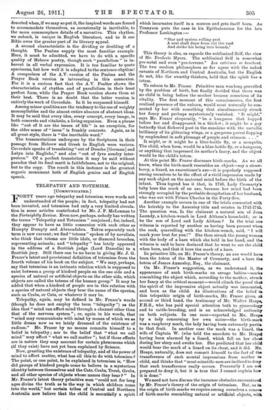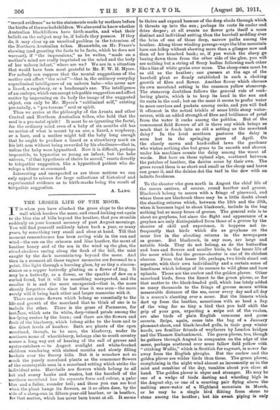F ORTY years ago telepathy and totemism were words not understanded
of the people; in fact, telepathy had not been invented, and totemism had only a very limited circula- tion in some articles contributed by Mr. J. F. McLennan to the Fortnightly Review. Even now, perhaps, nobody has written the terms " Telepathy and Totemism " conjoined; for, indeed, they appear to have as little connexion with each other as Humpty Dumpty and Abracadabra. Taken separately each term is now current; we find " totems " spoken of by novelists, who think that totems are little idols, or diamond brooches, representing animals; and " telepathy " has lately appeared in the address of a Scottish judge (Lord Dunedin) to a Scottish jury. Still there can he no harm in giving Mr. J. G. Frazer's latest and provisional definition of totemism from the fourth volume of his book on the subject. "We may, perhaps, say that totemism is an intimate relation which is supposed to exist between a group of kindred people on the one side and a species of natural or artificial objects on the other side, which objects are called the totems of the human group." It may be added that when a kindred of people are in this relation with a species of natural objects they bear the name of the species, such as Crabs, or Cats, or whatever it may be.
Telepathy, again, may be defined in Mr. Frazer's words (though he does not employ the term "telepathy ") as the idea that " mind can affect mind through a channel other than that of the nervous system "; or, again in his words, that "mind may communicate with mind by means of which we as little dream now as we lately dreamed of the existence of radium." Mr. Frazer by no means commits himself to a belief in telepathy ; nor to the belief that " what we call mind" may affect " what we call matter "; but if these effects are in nature they may account for certain phenomena which (if they exist) have not yet been explained by Science.
Now, granting the existence of telepathy, and of the power of mind to affect matter, what has all this to do with totemism The point, or one point, to be explained in totemism is, "How did groups of kindred people come to believe in a mysterious identity between themselves and the Cats, Crabs, Trout, Grubs, and all other species of objects whose names they bear?" In Mr. Frazer's latest theory primitive man "could not for long ages divine the truth as to the way in which children come into the world," but certain tribes of Central and Northern Australia now believe that the child is essentially a spirit
which incarnates itself in a. matron and gets itself born. As Tennyson puts the case in his Epithala.mium for the late Professor Lushington r-
" Star and system rolling past A soul shall draw from out the vast And strike his being into bounds.'
This theory is also, as regards the sublimized Self, the view of Mr. Frederic Myers. The subliminal Self is somewhat
pre-natal and even " pre-terrene." Les extremes Sc touchent. The two modern philosophers so far agree with the naked savants of Northern and Central Australia, but the English do not, like the swarthy thinkers, hold that the spirit has a totem.
To return to Mr. Frazer. Primitive man was long gravelled by the problem of birth, but finally decided that there was no child in being before the mother became conscious of its vitality. The first moment of this consciousness, the first realized presence of the unborn, would most naturally be con- nected by her with something that simultaneously struck her fancy and perhaps mysteriously vanished. " It might," says Mr. Frazer eloquently, " be a kangaroo that hopped before her and disappeared in a thicket ; it might be a gay butterfly that flickered past in the sunshine with the metallic brilliancy of its glittering wings, or a gorgeous parrot flapping by resplendent in soft plumage of purple and crimson. . . ."
It might, or it might be a blue-bottle fly, or a mosquito. The child, when born, would be a blue-bottle fly, or a kangaroo, or anything that impressed its mother's fancy, and the object would be the child's totem.
At this point Mr. Frazer discusses birth-marks. As we all know, when the birth-mark resembles an object—say a straw- berry, a lizard, an executioner's axe—it is popularly supposed among ourselves to be the effect of a vivid impression made by any such object on the maternal mind before the birth of the infant. Thus legend has it that, in 1746, Lady Cromarty's baby bore the mark of an axe, because her mind had been strongly occupied by the probable decapitation of her husband, who was out with Prince Charles in the Forty-five.
Another example occurs in one of the trials connected with the heirship to the Annesley title and estates in 1743-1745. The question was, Is the claimant a natural son of Joan Laundy, a kitchen-wench in Lord Altham's household ; or is he the son of Lord and Lady Altham P In the trial one witness is reported by another as having been present when the cook, quarrelling with the kitchen-wench, said, " I will mark your brat for you!" She then struck the young woman with the body of a hare which she held in her hand, and the witness is said to have declared that he went to see the child when born, and that it bore the mark of a hare.
In primitive life, on Mr. Frazer's theory, an axe would have been the totem of the Master of Cromarty, and a hare the totem of James Annesley, Esq., the claimant.
On Mr. Frazer's suggestion, as we understand it, the appearance of such birth-marks on savage babies—marks resembling the object which, according to the mother, struck her fancy at the critical moment—would clinch the proof that the spirit of the impressive object actually was incarnated, and born as the child. As illustrations of the belief is this telepathic origin of birth-marks, Mr. Frazer gives, at second or third hand, the testimony of Mr. Walter Heape, F.R.S., who has paid special attention both to gynaecology and to cattle-breeding, and is an acknowledged authority on both subjects. In one case—reported to Mr. Heap. by a lady concerning her own sister—the birth-mark was a raspberry mark, the lady having been extremely partis to that fruit. In another case the mark was a lizard, the wife of Captain W. (who told the anecdote to Mr. Heaps) having been alarmed by a lizard, which fell on her chest during her sleep and awoke her. She predicted that her chili would bear the mark of a lizard on its chest, and it did. Mr. Heape, naturally, does not commit himself to the fact of the transference of such mental impressions from mother to child, and thinks that "most scientific men are inclined to deny that such transference really occurs. Personally I am not prepared to deny it, but it is true that I cannot explain how it is done."
We need not here discuss the immense obstacles encountered by Mr. Frazer's theory of the origin of totemism. But, as to the origin of birth-marks we require among ourselves a census of birth-marks resembling natural or artificial objects, with "record evidence" as to the statements made by mothers before the births of the marked children. We also need to know whether Australian blackfellows have birth-marks, and what their beliefs on the subject may be, if beliefs they possess. If they do, it may clear up an unsolved problem in the totemism of the Northern Australian tribes. Meanwhile, on Mr. Frazer's showing (and granting the facts to be facts, which he does not warrant), if "the impressions," as he writes, "made on a mother's mind are really imprinted on the mind and the body of her unborn infant," where are we ? We are in a situation that would have been most grateful to Mr. F. W. H. Myers. For nobody can suppose that the mental suggestions of the mother can affect " the mind "—that is, the ordinary everyday supraliminal intelligence of an unborn babe—who never saw a lizard, a raspberry, or a headsman's axe. The intelligence of an embryo, which can accept telepathic suggestion and affect matter by impressing on its body the image of the suggested object, can only be Mr. Myers's "subliminal self," existing pre-natally, a " pre-terrene " soul or spirit.
, Thus we arrive at the philosophy of the Arunta and other Central and Northern Australian tribes, who hold that the soul is a pre-natal spirit ! It must be so (granting the facts), for the ordinary mind even of a baby of six months old has no notion of what is meant by an axe, a lizard, a raspberry, or a hare, and a mother might tell the baby long enough that he ought to produce a lizard or a strawberry mark on his left arm without being rewarded by his obedience—that is, unless the baby were hypnotized. Now it is difficult, perhaps impossible, to hypnotize so young an infant, but the babe unborn, "if that hypothesis of theirs be sound," reacts directly to telepathic suggestion, like a hypnotized patient who de- velops a blister at command.
Interesting and unexpected as are these notions we can only appeal to science for large collections of historical and experimental evidence as to birth-marks being the result of telepathic suggestion.
A. LANG.



































 Previous page
Previous page